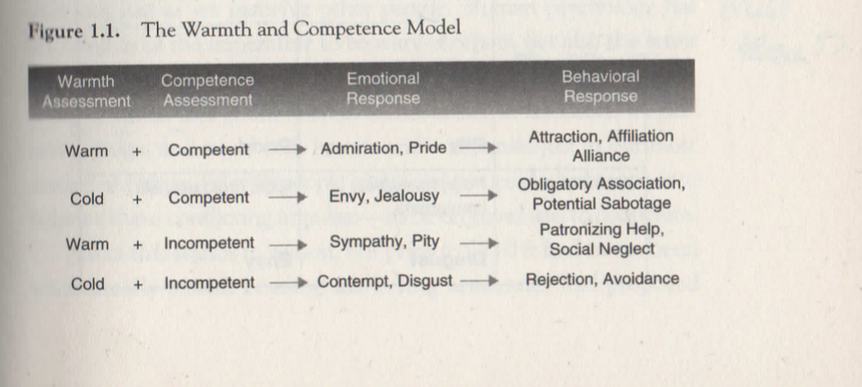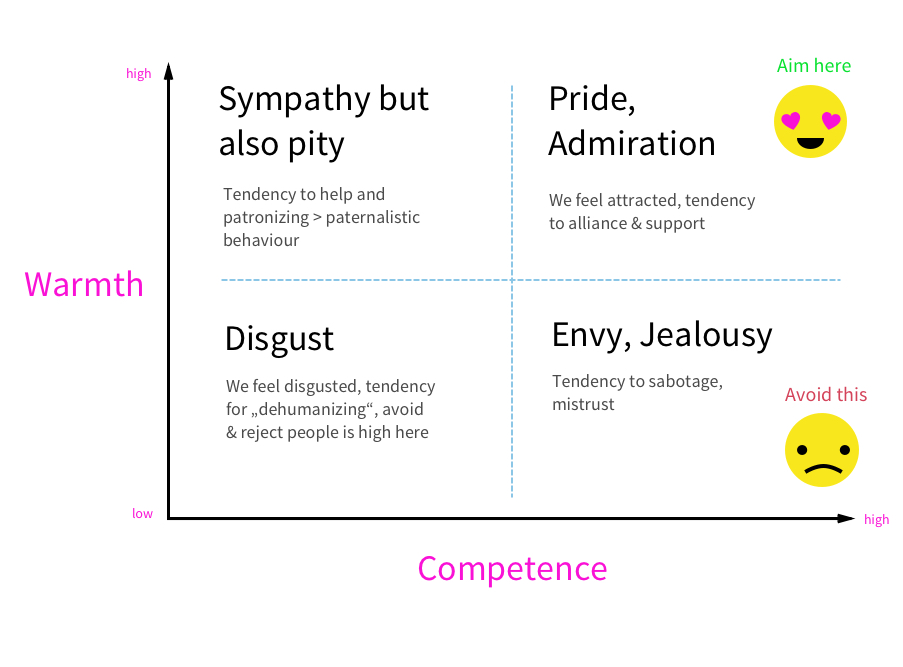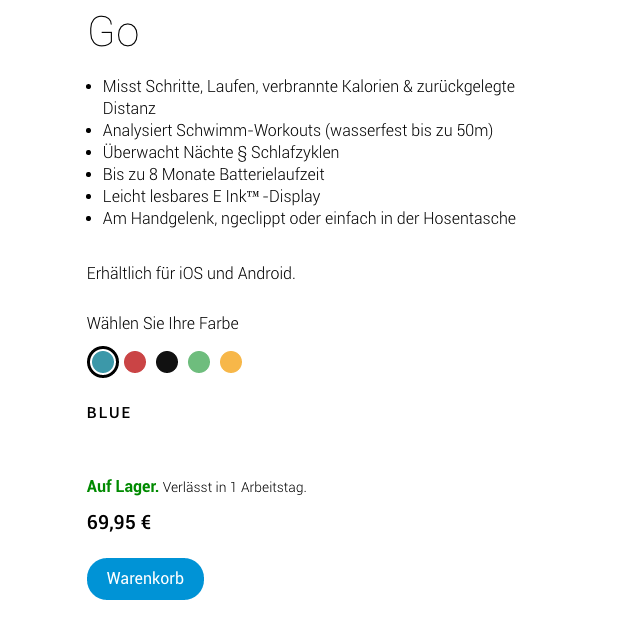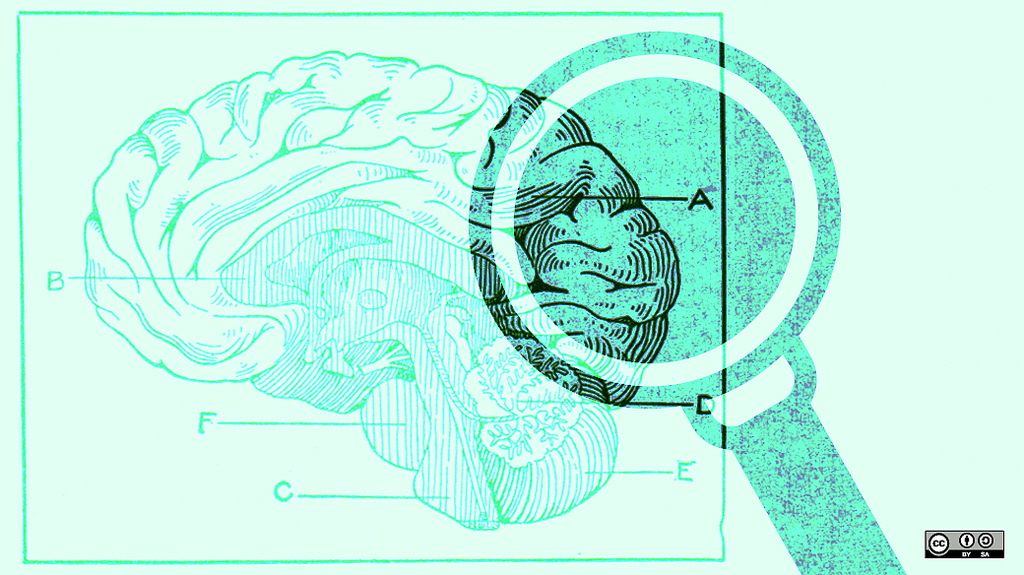Inhaltsverzeichnis:
Summary
Social psychology theories such as the stereotype content model have a huge impact on your user experience work because more and more interactions between companies and customers are taking place through a „digital window“ called a user interface. The perception and therefore the behaviour of digital interfaces influence brand perception. This can serve as a basis for improving your customer loyalty, as a growing body of research suggests that people have emotional relationships with brands that resemble relations between people.
„If we want users to like our software, we should design it to behave like a likeable person: respectful, generous and helpful.“
Cooper, A. „The Inmates are Running the Asylum. Why High-Tech Products Drive Us Crazy and How to Restore the Sanity“ (1999)
Earlier this year I read „The Human Brand“, by social psychologist Susan T. Fiske and Chris Malone, a brand consultant. I have been a huge fan of Fiske’s work ever since the Stereotype Content Model and its main dimensions of warmth and competence, were introduced to our course during my first semester in psychology. It is based on solid research and helps explain how we perceive people.
Before considering why social psychology principles can be useful for your product/brand’s success, I will ask three (rhetorical) questions up front: One about your preferred company-customer interaction, one about your preferred brand perception and one about your relationship toward inanimate objects.
If you had the choice, what would you choose?
A short termed profit-based approach or customers who love you – which may be a slower but more long-termed approach?
Today, most companies are separated from direct product-customer interaction. Online shops often seem impersonal. If the same product is available elsewhere for less money, customers might go and buy it there. In this case, customer behaviour is short-termed and more price-focused – there is no loyalty attached to a specific brand or company.
But you may have realized a movement: small shops and companies, those who prefer a direct company-customer interaction and a personal approach towards their customers, are gaining interest – even if they are more expensive. This is because their customers feel emotionally engaged. They feel valued as a person because they experience a direct, personal relationship. This experience generates positive feelings towards the company. People value this personal, more emotional approach over money. These relationships are also associated with trust.
2) How would you like your brand/product to be perceived?
Do you ensure that your digital product meets this desired perception?
We all (hopefully) know that a brand does not only consists of a logo, a claim, and some corporate colours. A brand is much more. It is made up of the people who interact, see and perceive that brand – or get in touch with it. It is a combination of subtle cues, feelings, and emotions they have towards this product/brand and the company behind it.
These „touchpoints“ could be your customer service agent, your product itself, your TV commercial, a salesperson, your newsletter, the CEO talking in a TV Show, your social media presence and the tone of voice, a simple flyer and of course your website (app, digital product).
It should be clear that a user interface (of a website, an app or any digital product) always represents your brand – it is simply how your company communicates with its customers – through a digital interface. The fact that this communication happens via a digital interface does not mean this communication is less important.
You get it: Everything that communicates with the outside world represents your brand and forms an image of your „personality“ (brand personality) within peoples‘ heads. But this does not mean that you are out of control.
No company would give a job to people like a customer service agent who is rude, unpolite or behaves intrusive – but sadly, digital products often behave this way: they are intrusive, rude, unfriendly and anything but polite. Negative behaviour or any negative perceived interaction will shape how your brand – and therefore, your company – is perceived by people. It cannot be your goal that this should be a negative image.
Careful considerations about the user interface, used by your clients, customers or employees are worth all the time! This does not only influence the „look and feel“, and the visual interface, but it also affects the behaviour and frequently goes beyond the digital world. It can also affect analogous company structures such as a workflow in certain scenarios like, for example, the „cancel subscription/account“ process.
3) Have you ever yelled at your computer?
Yes? Congrats, you are applying social heuristics to inanimate things.
People often describe their relationships with things, brands and companies in a human way – for example, we love apple products, we hate our printer, and we yell at inanimate objects like copy machines.
Why do we do that? Why do we interact with those things in a „human“ way? The printer will not hear you, and it does not care.
People apply the same social heuristics used for human-to-human interactions to products and brands because they (the products and brands) call to mind similar social attributes as fellow humans do.
In their book „The Media Equation. How People Treat Computers, Television, and New Media Like Real People and Places“ (1996) Clifford Nass and Byron Reeves, both professors at Stanford University, demonstrated that humans react to computers, in the same way, they react to other humans.
Susan Fiske and Chris Malone, authors of „The Human Brand“, evaluated over 45 companies, across ten separate studies of how people perceive these companies towards the two main categories we use to assess people: Warmth and competence. They claim that people perceive brands in the same way they perceive people.
The Stereotype Content Model and its warmth & competence dimensions.
The Stereotype Content Model is a social psychology theory first proposed by social psychologist Susan T. Fiske and her colleagues in 2002. According to the theory, we judge people on two main dimensions: warmth & competence. These judgments also drive our behaviour toward others. Warmth and competence are universal dimensions of social cognition that enable us to assess our in-group peers and foreign groups or members. It is a „Is this a friend or foe?“ question originating from the old brain.
Warmth and competence drive our emotions and behaviour, not only towards other people but towards inanimate objects like brands & products. The model can serve as a framework for how a customer’s experience is linked to brand perception.
As we have learned, a website, digital product or application represents your brand to the outside world. The visual design and the behaviour – the interactions between a human and a website, digital product or application – mirror the brand’s personality.

Design for high warmth and high competence
If we perceive a brand high on both dimensions, warm & competent, we believe the brand has worthy intentions towards us. We trust this brand. It is like a friend.
But often, a company sees itself high on warmth and competence, full of good intentions towards its customers and even praises itself this way – but is not perceived this way.
When we take a closer look, it is often not the famous customer first – but rather a company first approach, that we, as user experience designers see implemented in digital user interfaces (and even beyond in non-digital workflows, too).

Warmth implies that we can trust someone – it asks: „What are the intentions of someone towards me?“ Warmth is also more dominant than competence. While competence is important, people will leave when they realize that you do not have a worthy intent towards them.
To illustrate the „warmth“ dimension, let us look at the „delete account“ pattern. The „delete account“ pattern is a fitting example because it represents a point where customer and business goals differ highly.
Instead of making it easy for people to leave, companies often make it nearly impossible to delete accounts or subscriptions – they lock the door and force their customers to stay inside. Would you recommend this company to your friends? On the Stereotype Content Model, the „rating“ may be low on the warmth and high on the competent dimension, which says that the company is competent enough to realize its bad intentions towards us. In this case, the intentions seem unfriendly – perhaps even hostile towards us. This leads to mistrust. Rude behaviour on social media and customer service hotlines and not reacting to criticism belong in the same category.
Competence asks how capable one will be in carrying out those (good or bad) intentions. The judgment on this dimension happens soon after you have judged someone on the warmth dimension.
To illustrate the competent dimension, imagine you are interacting with new software. Imagine being confronted with sloppy, automatically generated translation. This will lead to mistrust as well. The interaction may be rated high on the warmth, but low on the competence dimension.

Imagine a sloppy written/translated error message appears while such a sensitive process like online shopping or even money transaction. Perhaps you like and trust that service/brand but after that experience chances are high that it may seem less trustworthy to you. If they cannot handle translation on an official service/product website, what else do they lack / do not care about?

We hope this article gave an impression of how we can use social psychology theories in our daily work as user experience consultants because interacting with a digital product is interaction with your brand.
Sources and further reading
- Fiske, Cuddy, Glick, & Xu,l. (2002) A model of (often mixed) stereotype content: competence and warmth respectively follow from perceived status and competition.
- Malone C., Fiske S. (2013) The Human Brand. How we relate to people, products, and companies.
- The Media Equation: How People Treat Computers, Television, and New Media Like Real People and Places, Byron Reeves and Clifford Nass (Cambridge University Press, 1996)
Image
https://www.flickr.com/photos/opensourceway/6006414578/





